FAQ - Advanced Bathroom Queries
What Is a Flush Valve on a Toilet

Our aim is to clarify the complexities of how your toilet operates by shining a light on the frequently underestimated champion – the flush valve. This crucial element is key to the optimal performance of your toilet, guaranteeing a strong and effective flush.
In this article, we’ll delve into the anatomy of a flush valve, how it works, common problems, maintenance tips, and even upgrading options.
Get ready to master the art of toilet technology with your newfound knowledge of the flush valve.
Key Takeaways
- The flush valve is responsible for proper flushing of waste from the toilet bowl.
- Understanding the components (flapper, overflow tube, fill tube) is essential for proper flushing.
- Common flush valve issues include faulty flappers, clogged overflow tubes, and disconnected refill tubes.
- Regular maintenance and inspection can prevent and troubleshoot flush valve issues.
Importance of the Flush Valve
One of the most important components of a toilet is the flush valve. The flush valve is responsible for the proper flushing of waste from the bowl. It’s a mechanism that opens and closes to allow water to enter the bowl and remove the waste.

Maintaining the flush valve is crucial for the toilet’s optimal performance. Regular maintenance includes cleaning the valve to remove any debris or buildup that may affect its function. If the flush valve becomes worn or damaged, it may need to be replaced. This can be done by following a few simple steps, such as turning off the water supply, removing the old valve, and installing the new one.
Proper flush valve maintenance and replacement ensure that the toilet functions efficiently and prevents any potential issues with flushing.
Anatomy of a Flush Valve
To understand the anatomy of a flush valve, we need to examine its components and how they work together to ensure proper flushing of waste from the toilet bowl. The flush valve is a crucial part of the toilet system, responsible for releasing a large amount of water into the bowl to remove waste effectively.
Here are the key components and their functions:

- Flapper: This rubber or silicone disc seals the opening between the tank and the bowl. When the flush lever is pressed, it lifts the flapper, allowing water to flow into the bowl.
- Overflow Tube: Situated inside the flush valve, this tube prevents the tank from overflowing by redirecting excess water into the bowl.
- Fill Tube: This small tube refills the bowl with water after flushing, ensuring a clean bowl for the next use.
Flush Valve Components
When it comes to flush valve components, understanding their function and design is crucial.
The valve is responsible for regulating the flow of water from the tank to the bowl during a flush.
It consists of various parts, such as the flapper, overflow tube, and refill tube, which work together to ensure proper flushing.
However, these components can sometimes experience issues like leaks or clogs, causing the toilet to malfunction.
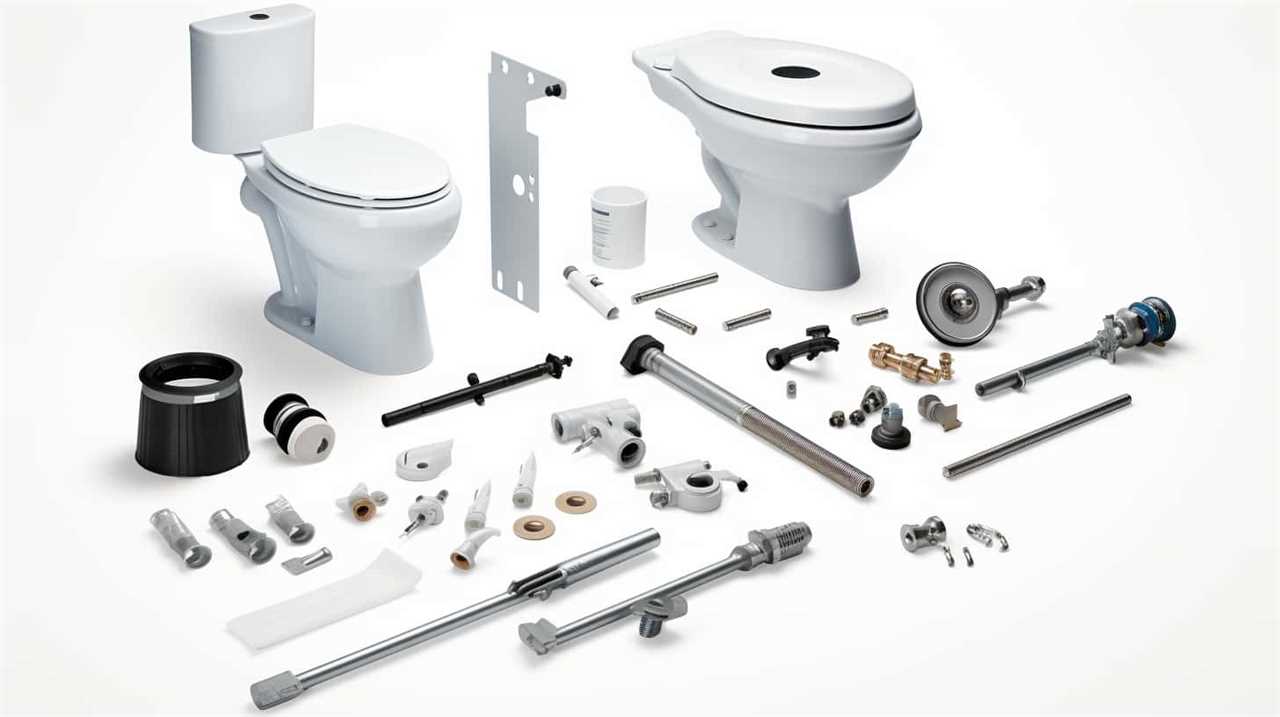
Valve Function and Design
We use a flush valve on our toilets to control the flow of water during the flushing process. Understanding the function and design of the flush valve is essential for proper valve maintenance and repair. The flush valve consists of several components that work together to ensure efficient and effective flushing.
Here are the main components of a flush valve:
- Flapper: The flapper is a rubber or plastic disc that covers the flush valve opening. It’s connected to the flush lever and lifts up when the lever is pressed, allowing water to flow into the toilet bowl.
- Overflow tube: The overflow tube prevents the toilet from overflowing by directing excess water into the toilet bowl.
- Fill valve: The fill valve controls the water level in the toilet tank by regulating the flow of water into the tank. It’s connected to the water supply line and shuts off when the tank is full.
Understanding these components and their functions will help in diagnosing and resolving any issues with the flush valve, ensuring smooth operation and minimizing the need for valve repair.
Common Flush Valve Issues
As we explore common flush valve issues, it’s important to understand the various components of the flush valve and how they can contribute to potential problems. The flush valve is made up of several key parts, including the flapper, the overflow tube, and the refill tube.

One common issue is a faulty flapper, which can lead to continuous water running and a leaky toilet. To troubleshoot this problem, check for any debris or mineral deposits that may be preventing the flapper from sealing properly.
Another common repair involves the overflow tube, which can become clogged with sediment or debris, causing the water level in the tank to rise too high. To fix this, remove the clog or replace the tube if necessary.
Finally, the refill tube may become disconnected or damaged, resulting in inadequate filling of the tank after a flush. Inspect and reattach the tube if needed.
How Does a Flush Valve Work
The flush valve on a toilet is responsible for releasing water from the tank into the bowl to initiate the flushing process. Understanding how a flush valve works is essential for maintaining the proper functioning of a toilet.
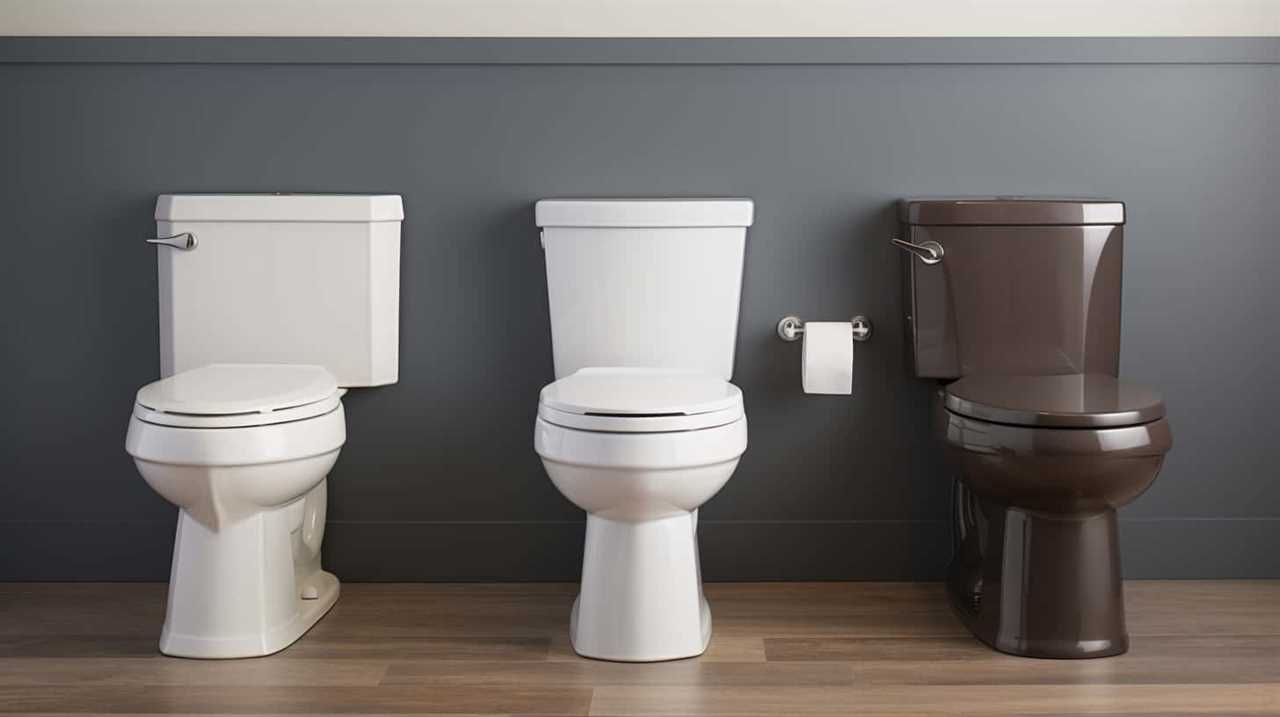
Here is a breakdown of the flush valve mechanism:
- Types of Flush Valves:
- Flapper Valve: This is the most common type of flush valve found in toilets. It consists of a rubber flapper that covers the valve opening in the bottom of the tank. When the flush lever is pressed, it lifts the flapper, allowing water to rush into the bowl.
- Piston Valve: This type of flush valve uses a piston mechanism to control the release of water. When the flush lever is pressed, it lifts the piston, which opens the valve and allows water to flow into the bowl.
Understanding the different types of flush valves and how they work can help troubleshoot any issues that may arise and ensure proper functioning of your toilet.
Types of Flush Valves
There are two main types of flush valves commonly used in toilets.
The first type is the flapper valve, which is a rubber or plastic flap that covers the flush valve opening. When the toilet is flushed, the flapper valve lifts up, allowing water to flow from the tank into the bowl.

The second type is the flush valve tower, also known as a canister valve. This type of flush valve uses a cylindrical tower that lifts up when the toilet is flushed, allowing water to rush into the bowl.
Both types of flush valves require regular maintenance to ensure proper functioning. This includes checking for any leaks, cleaning the valve and its components, and replacing any worn-out parts.
In case of a malfunction, flush valve replacement may be necessary.
Benefits of a Properly Functioning Flush Valve
Maintaining a properly functioning flush valve is essential for efficient water flow and preventing potential leaks or malfunctions. A properly installed flush valve offers several benefits, including:
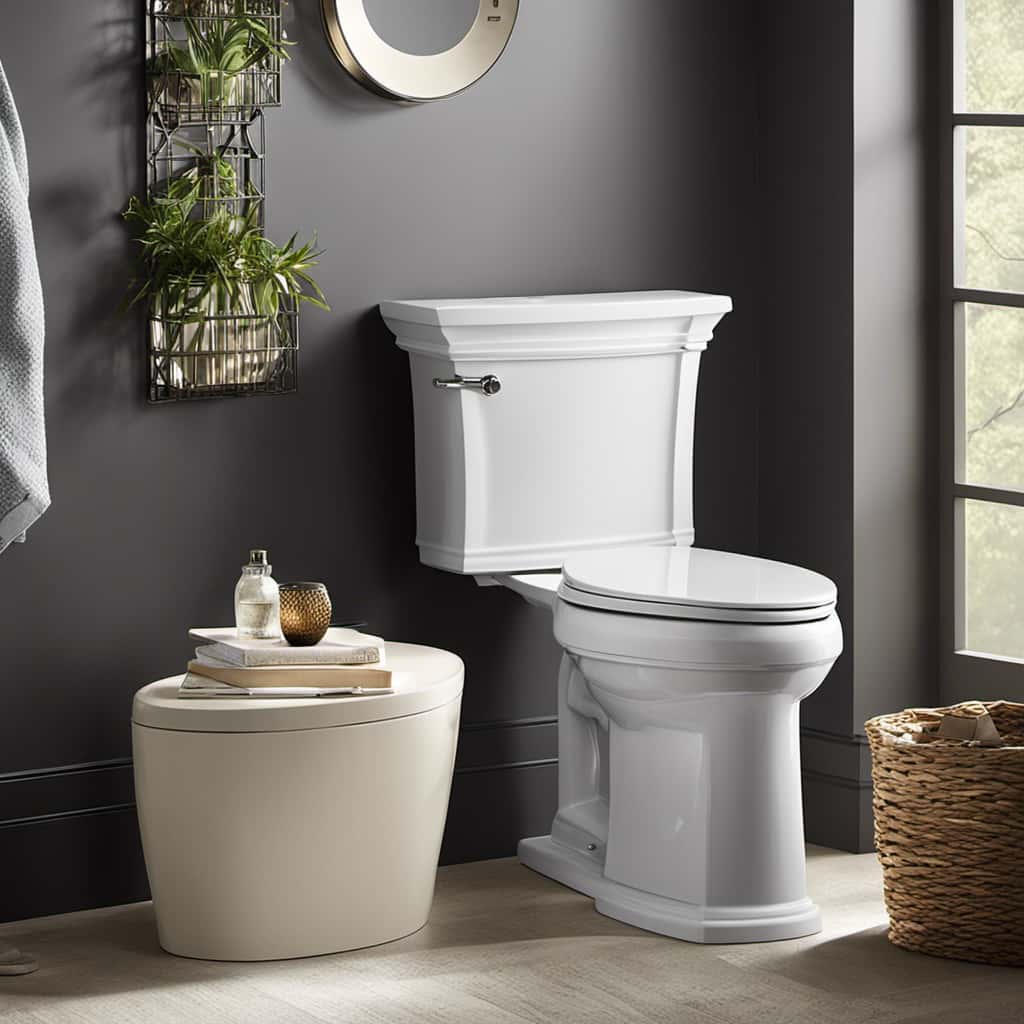
- Water Conservation: A properly functioning flush valve ensures that the right amount of water is used for each flush. This helps to conserve water and reduce utility bills.
- Prevents Clogs: A flush valve that’s working correctly helps to prevent clogs by providing a strong and consistent flush, effectively clearing the waste from the toilet bowl.
- Extended Lifespan: Proper flush valve installation and regular maintenance can significantly extend the lifespan of the valve. This reduces the need for frequent repairs or replacements, saving both time and money.
Signs of a Faulty Flush Valve
When it comes to a faulty flush valve, there are some common signs to look out for. These include:
- A weak or incomplete flush
- Water constantly running into the toilet bowl
- A toilet that won’t flush at all
If you’re experiencing any of these issues, it’s important to troubleshoot the problem to determine the cause and find a solution.
Common Flush Valve Issues
We often encounter common flush valve issues, which are clear signs of a faulty flush valve. When troubleshooting a flush valve problem, there are a few key issues to look out for:
- Insufficient flushing: If the toilet fails to flush properly or only partially empties the bowl, it could indicate a faulty flush valve. This can be caused by a worn-out or misaligned flapper valve that doesn’t seal properly.
- Continuous running: If you notice that the water in the toilet tank keeps running even after the flush, it’s likely due to a faulty flush valve. This could be caused by a worn-out flapper valve that doesn’t close tightly, allowing water to continuously flow into the bowl.
Fixing a faulty flush valve typically involves replacing the flapper valve or adjusting its alignment. Regular maintenance and inspection can help prevent these common issues and ensure the proper functioning of the flush valve.

How to Troubleshoot
To troubleshoot signs of a faulty flush valve, it’s important to be aware of certain indicators that may suggest an issue.
One common sign is when the toilet continuously runs after flushing. This could indicate a problem with the flush valve not sealing properly.
Another sign is when the toilet fails to flush adequately, leaving waste behind. This could be due to a weak or faulty flush valve.
Additionally, if you notice water leaking from the tank into the bowl, it could be a sign of a faulty flush valve.
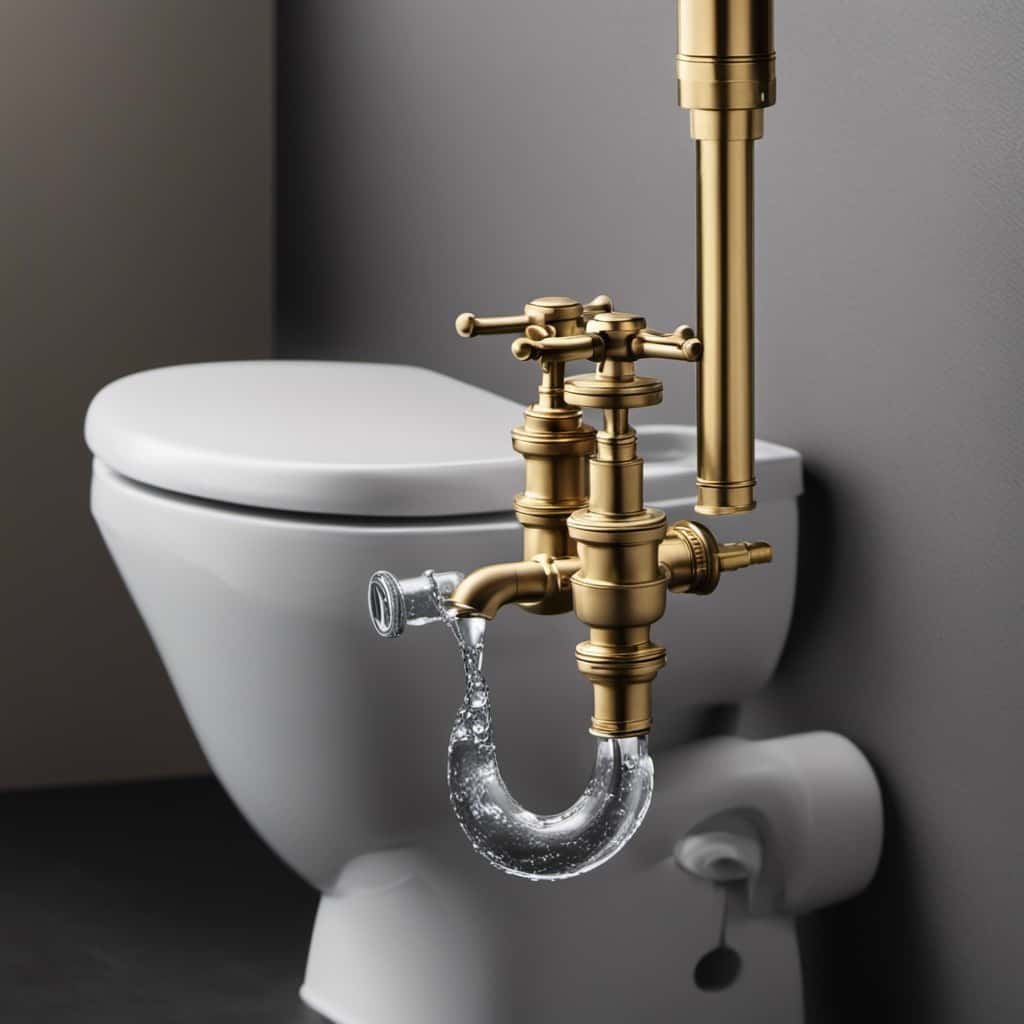
To troubleshoot these issues, you can try adjusting the chain connected to the flush valve or cleaning any debris that may be obstructing the valve’s proper functioning.
If these troubleshooting techniques don’t resolve the issue, it may be necessary to replace the flush valve.
Common Flush Valve Problems
One of the most common problems with a flush valve on a toilet is the leakage of water. This issue can lead to wasted water and higher water bills if not addressed promptly.
To help you troubleshoot and repair a faulty flush valve, here are some useful tips:

- Inspect the flapper: The flapper is a rubber seal that controls the flow of water from the tank to the bowl. Check for any signs of wear or damage and replace if necessary.
- Check the chain: Ensure that the chain connecting the flapper to the flush handle is properly adjusted. If it’s too tight or loose, it can affect the flush valve’s performance.
- Test the water level: Adjust the water level in the tank to ensure it’s not too high or too low, as both can cause problems with the flush valve.
- Clean the valve seat: Sediment and mineral buildup can prevent the flush valve from sealing properly. Clean the valve seat using a brush or vinegar to remove any deposits.
How to Maintain a Flush Valve
Now let’s talk about how to maintain a flush valve.
Regular cleaning methods, such as using vinegar or a toilet cleaner, can help remove any buildup or debris that may affect the valve’s performance.
Additionally, it’s important to address common maintenance issues, such as leaks or loose connections, promptly to ensure the flush valve continues to function properly.
Regular Cleaning Methods
To maintain a flush valve in proper working condition, we regularly clean it using simple and effective methods. Here are some regular maintenance and cleaning techniques for a flush valve:
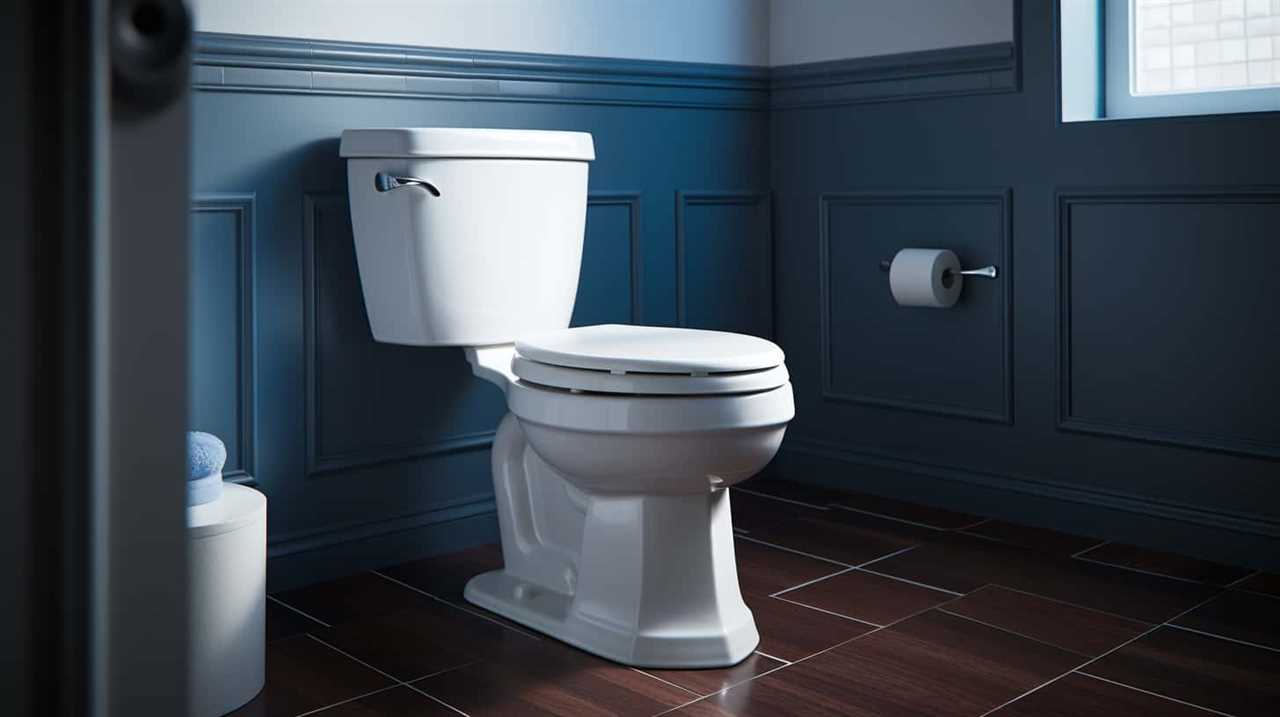
- Inspect and Remove Debris: Regularly inspect the flush valve for any debris or buildup. If you notice any, remove it using a soft brush or sponge.
- Clean with Vinegar Solution: Mix equal parts of vinegar and water in a spray bottle. Spray the solution onto the flush valve and let it sit for a few minutes. Scrub the valve gently with a brush and rinse thoroughly.
Note: Vinegar helps dissolve mineral deposits and disinfect the valve.
- Use a Toilet Bowl Cleaner: Apply a toilet bowl cleaner specifically designed for removing stains and buildup. Follow the instructions on the cleaner’s packaging, scrub the valve gently, and rinse thoroughly.
Note: Ensure the cleaner is safe for the flush valve material.
Regularly performing these cleaning techniques will help keep your flush valve in optimal condition and prevent any potential issues.
Common Maintenance Issues
First, we’ll address the common maintenance issues that arise when maintaining a flush valve. It’s important to troubleshoot any problems with the flush valve to ensure proper functioning of your toilet.
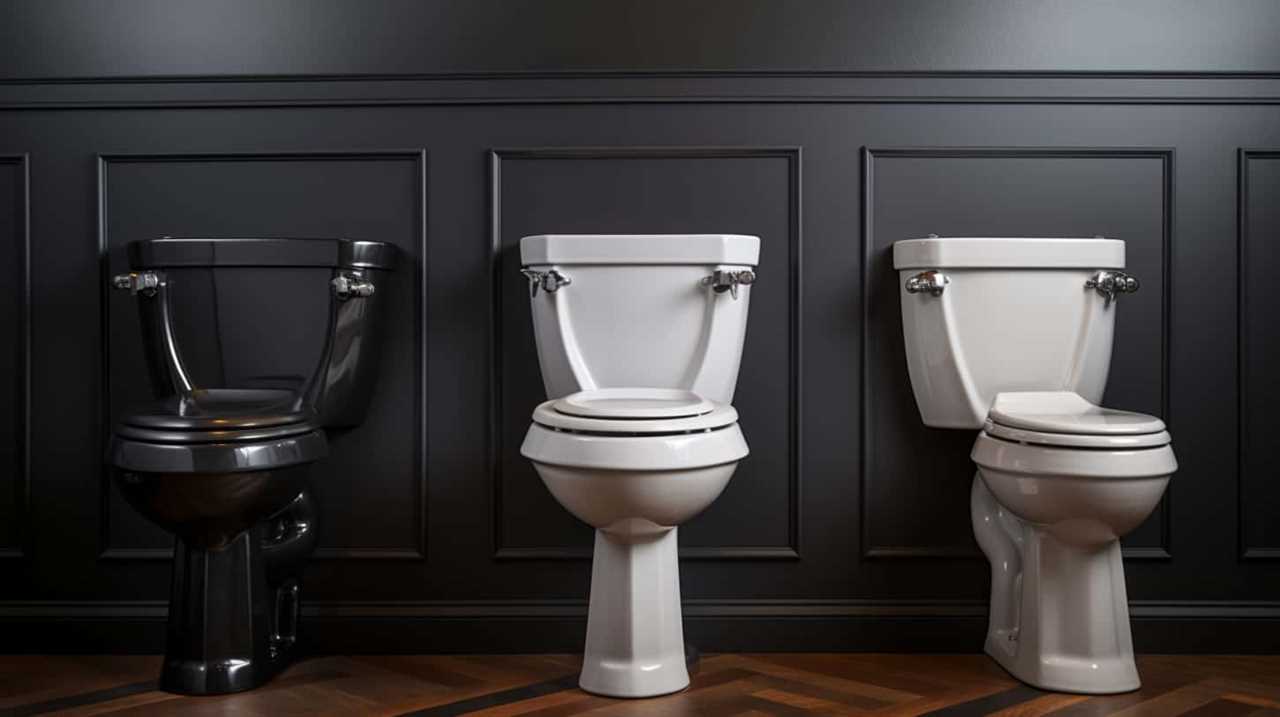
One common issue is a weak or incomplete flush. This can be caused by a clogged flush valve or a faulty flapper. To fix this, you can try cleaning the flush valve with a brush or using a plunger to clear any obstructions.
Another common problem is a continuously running toilet. This can be due to a worn-out flapper or a faulty fill valve. DIY repairs for this issue include replacing the flapper or adjusting the fill valve.
Preventing Future Problems
To prevent future problems, we should regularly maintain the flush valve in our toilets. Here are some troubleshooting tips and preventive measures to avoid leaks and ensure the proper functioning of the flush valve:
- Regular cleaning: Clean the flush valve at least once every three months to remove any mineral deposits or debris that may hinder its operation.
- Check for leaks: Inspect the flush valve for any signs of leakage, such as water pooling around the base of the toilet or a constant running sound. If you notice a leak, replace the faulty gasket or flapper immediately.
- Adjust the chain or rod connecting the flush valve to the handle to ensure proper alignment and prevent leaks.
- Lubrication: Apply a thin layer of silicone-based lubricant to the flush valve’s moving parts to reduce friction and prolong its lifespan.
Upgrading Your Flush Valve
We recommend upgrading your flush valve to improve the performance and efficiency of your toilet. Upgrading your flush valve can provide several benefits, including better flushing power, reduced water usage, and decreased likelihood of clogs. When considering upgrading options, there are a few factors to keep in mind, such as the type of flush valve that is compatible with your toilet model and the cost considerations associated with the upgrade.
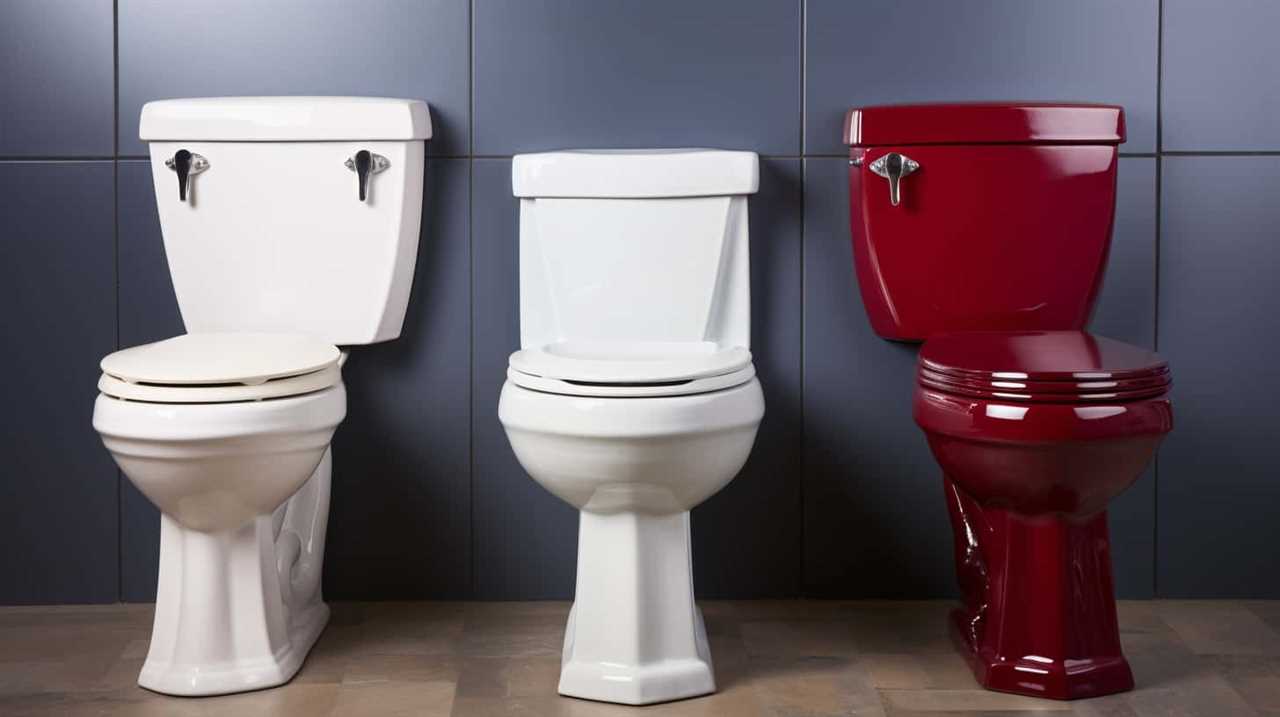
To help you make an informed decision, we have provided a table below outlining different types of flush valves and their associated costs:
| Flush Valve Type | Cost |
|---|---|
| Flapper Valve | $10 – $20 |
| Dual Flush Valve | $30 – $50 |
| Pressure Assist Valve | $100 – $200 |
Troubleshooting Flush Valve Issues
When troubleshooting flush valve issues, our team recommends checking for any blockages or leaks in the system. Here are the steps to fix a faulty flush valve:
- Inspect for blockages:
- Check if there’s any debris or foreign objects obstructing the valve.
- Use a flashlight to carefully examine the valve and remove any visible blockages.
- If the valve appears clear, try flushing with a bucket of water to see if it flushes properly.
- This will help determine if there’s a blockage further down the drain pipe.
- Check for leaks:
- Inspect the area around the flush valve for any signs of water leakage.
- Look for puddles, water stains, or dampness.
- If a leak is detected, tighten the bolts connecting the flush valve to the tank.
- If this doesn’t solve the issue, a faulty gasket or seal may need to be replaced.
Frequently Asked Questions
Can I Repair a Faulty Flush Valve on My Own?
Yes, we can repair a faulty flush valve on our own. Common flush valve problems include leaks and improper flushing. By following the proper steps and using the right tools, we can successfully fix the issue.
How Often Should I Replace a Flush Valve?
Flush valves typically last 5-10 years, but proper maintenance can extend their lifespan. Regularly cleaning the valve and avoiding harsh chemicals can prevent corrosion and ensure optimal performance.
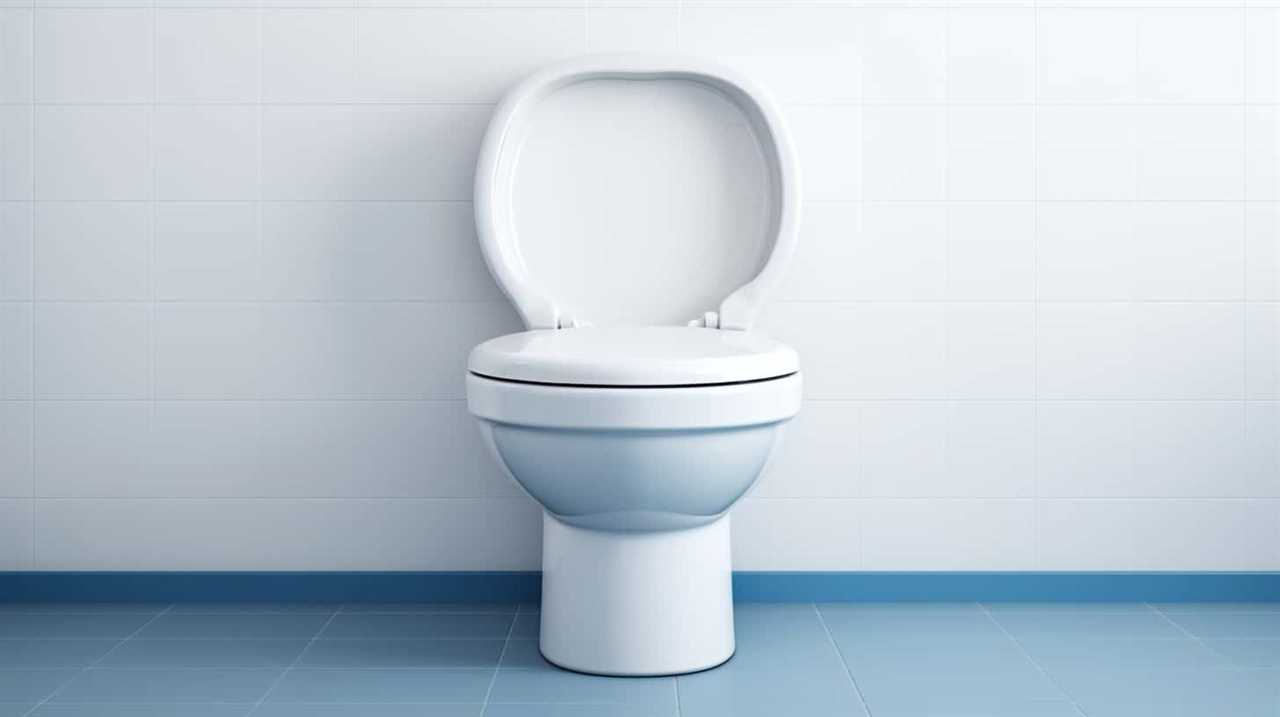
Is It Necessary to Upgrade My Flush Valve if It Is Functioning Properly?
We don’t need to upgrade the flush valve if it’s working well. However, for better performance and water efficiency, regular maintenance like cleaning and checking for leaks is recommended. Upgrading can provide benefits like improved flushing power and reduced water consumption.
What Are the Signs of a Flush Valve Problem That I Should Look Out For?
When it comes to flush valve problems, we need to be vigilant. Signs of leakage or slow flushing can indicate a malfunction. Common causes include worn seals or a faulty fill valve. Maintenance is crucial for a well-functioning toilet.
Can a Faulty Flush Valve Cause Water Leakage?
Yes, a faulty flush valve can cause water damage. It is a common problem in toilets. When the flush valve fails to seal properly, water can leak out, leading to potential damage and higher water bills.
Conclusion
In conclusion, the flush valve is like the beating heart of a toilet, ensuring the smooth flow of waste and maintaining proper hygiene. Its components work together seamlessly to create a powerful flush, preventing clogs and keeping your bathroom clean.

By understanding the anatomy and function of a flush valve, as well as knowing how to troubleshoot and maintain it, you can ensure the longevity and efficiency of your toilet.
So, pay attention to this unsung hero and keep your bathroom in tip-top shape.
With an impeccable eye for detail and a passion for bathroom-related, Ava leads our editorial team gracefully and precisely.
Under her guidance, Best Modern Toilet has flourished as the go-to resource for modern bathroom enthusiasts. In her free time, you might find Ava exploring antique shops and looking for vintage bathroom fixtures to add to her collection.
FAQ - Advanced Bathroom Queries
Why Won’t My Toilet Flush Without Power

If you’ve ever been stuck in a challenging situation during a power outage, frantically trying to figure out why your toilet isn’t flushing, don’t worry – we’re here to explain this common dilemma.
In this article, we’ll explore the role of electricity in toilet flushing and delve into the components of a power-dependent flushing system. We’ll also uncover the reasons behind toilet flushing failure during power outages and provide alternative methods to ensure a functional toilet, even without power.
So, let’s dive in and master the art of flushing without electricity!
Key Takeaways
- Electricity is essential for the flush mechanism of modern toilets.
- Power outages can disrupt the functioning of the components that control flushing.
- Alternative methods for flushing a toilet without power include manually filling the tank, pouring water into the bowl, or using portable toilet options.
- Preparing for power outages involves installing backup power sources, stocking up on water, considering water-saving toilets, and educating oneself on alternative flushing methods.
The Role of Electricity in Toilet Flushing
In our experience, the main role of electricity in toilet flushing is through the operation of the electrically-powered flush mechanism. This mechanism is responsible for initiating the flushing action by activating the water flow and creating the necessary pressure to remove waste from the bowl.

The impact of water pressure on toilet flushing can’t be overstated. Adequate water pressure ensures a strong and efficient flush, while low water pressure can result in incomplete waste removal and potential clogs.
The history of electricity in toilet technology dates back to the early 20th century when electrically-powered flush mechanisms were first introduced. Since then, advancements in technology have led to more efficient and effective flushing systems, improving overall toilet performance.
Understanding the role of electricity in toilet flushing is crucial for maintaining a properly functioning toilet system.
Components of a Power-Dependent Flushing System
To understand the components of a power-dependent flushing system, we need to examine the inner workings of the toilet. Power saving toilet technology has become increasingly popular due to its ability to reduce energy consumption and minimize the impact of power outages on water pressure. Let’s take a closer look at the key components involved in this system.

| Component | Function |
|---|---|
| Flapper valve | Controls the release of water from the tank into the bowl |
| Fill valve | Regulates the water level in the tank |
| Flush valve | Opens to allow water to flow into the bowl during flushing |
During a power outage, the lack of electricity can disrupt the functioning of these components, particularly the flapper valve. Without power, the flapper valve may fail to open, preventing the water from being released into the bowl. Additionally, the fill valve may not be able to replenish the water in the tank, leading to decreased water pressure and a weaker flush. Understanding these components helps us comprehend why a toilet may not flush without power.
Common Reasons for Toilet Flushing Failure During Power Outages
When power outages occur, we often experience toilet flushing failure due to several common reasons. One of the main causes is the reliance on electricity for the flushing mechanisms of modern toilets. These mechanisms, such as electric pumps or pressure-assisted systems, require power to operate. Without electricity, these mechanisms can’t generate the necessary force to flush the toilet effectively.
Another reason for flushing failure during power outages is a clogged or malfunctioning toilet. Blockages in the pipes or a faulty flush valve can impede the flushing process, even when power is available. Troubleshooting toilet flushing issues should involve checking for blockages, ensuring the flush valve is functioning properly, and considering alternative methods for flushing.
Understanding these common reasons for toilet flushing failure is crucial in finding solutions and ensuring proper functionality, especially during power outages. In the next section, we’ll explore alternative methods for flushing a toilet without power.

Alternative Methods for Flushing a Toilet Without Power
During power outages, when the reliance on electricity for toilet flushing mechanisms renders them ineffective, it’s important to consider alternative methods for flushing a toilet without power.
In emergency situations, there are several solutions that can be implemented to ensure proper sanitation and water conservation.
One option is to manually fill the toilet tank with water using a bucket or container. By pouring the water into the bowl, it will create enough force to flush the waste down the drain.
Another method is to use a portable camping toilet or a portable toilet seat that can be placed on top of a bucket or other container.

These emergency solutions can help maintain hygiene and prevent the spread of diseases during power outages, while also conserving water.
Preparing for Power Outages: Tips to Ensure a Functional Toilet
In order to prepare for power outages and ensure a functional toilet, we can continue the discussion by exploring some helpful tips. Here are three key suggestions to enhance toilet hygiene and emergency preparedness:
- Install a backup power source: Consider investing in a generator or a battery backup system to keep essential appliances, including your toilet, running during power outages. This will allow you to maintain proper sanitation even when the electricity is down.
- Stock up on water: Have an adequate supply of water stored for emergencies. You can use this water to manually flush the toilet by pouring it directly into the bowl. Aim for at least one gallon of water per person per day to cover your basic needs.
- Learn manual flushing techniques: Familiarize yourself with alternative methods for flushing the toilet without power. For instance, you can manually fill the toilet tank using a bucket of water to create enough pressure for a flush.
Frequently Asked Questions
How Does a Power Outage Affect the Operation of a Toilet?
During a power outage, a toilet may not flush because it relies on electricity to activate the flushing mechanism. Without power, the backup generator or emergency plumbing may be needed to restore functionality.
Can I Manually Flush a Toilet That Is Dependent on Electricity?
Yes, you can manually flush a toilet that relies on electricity. By using the emergency toilet flush or manually filling the tank and operating the lever, you can still achieve a functioning flush without power.

Are There Any Alternative Methods to Flush a Toilet Without Power?
Emergency toilet solutions include DIY toilet flush options. When there is no power, alternative methods can be used to manually flush a toilet. These methods ensure functionality during emergencies or power outages.
What Are the Common Reasons for Toilet Flushing Failure During a Power Outage?
The common reasons for toilet flushing failure during a power outage include a lack of power to operate the toilet flushing mechanism and potential issues with the water supply. Troubleshooting toilet flushing may involve checking the power source and ensuring proper water flow.
How Can I Prepare My Toilet for a Power Outage to Ensure It Remains Functional?
To prepare our toilet for a power outage and ensure it remains functional, we can take measures such as installing a backup generator, using water conservation techniques, and considering portable toilet options.
Conclusion
In conclusion, power outages can disrupt the functioning of toilets, which rely on electricity for flushing.

One interesting statistic to consider is that during a power outage, the average person flushes the toilet around 2,500 times per year.
This visualizes the potential inconvenience and importance of having alternative methods in place to ensure a functional toilet during such situations.
With an impeccable eye for detail and a passion for bathroom-related, Ava leads our editorial team gracefully and precisely.
Under her guidance, Best Modern Toilet has flourished as the go-to resource for modern bathroom enthusiasts. In her free time, you might find Ava exploring antique shops and looking for vintage bathroom fixtures to add to her collection.
FAQ - Advanced Bathroom Queries
Are You Allowed to Flush Toilet Paper

Are we overlooking the consequences of flushing toilet paper?
In this article, we explore the environmental consequences and plumbing issues associated with this common practice.
We’ll also delve into alternatives and proper disposal methods recommended by plumbing and environmental experts.
Join us as we navigate the complexities of this topic and gain a deeper understanding of whether we are allowed to flush toilet paper.

Get ready to master the art of responsible waste management.
Key Takeaways
- Flushing toilet paper contributes to water scarcity and wastes valuable water resources.
- Flushing too much toilet paper can lead to clogging and damage to sewage systems.
- Composting toilets and bidet attachments are sustainable alternatives to flushing toilet paper.
- Proper disposal methods, such as recycling and composting, help reduce the environmental impact of toilet paper.
Environmental Impact of Flushing Toilet Paper
Flushing toilet paper has a significant environmental impact, and we should be aware of its consequences. When we flush toilet paper, it contributes to two major environmental issues: water scarcity and deforestation.
Firstly, the production of toilet paper requires a significant amount of water. With water scarcity becoming a growing concern around the world, it’s important to recognize that flushing toilet paper wastes this valuable resource.
Secondly, the production of toilet paper contributes to deforestation. Trees are cut down to make pulp, which is then processed into toilet paper. This deforestation not only destroys ecosystems and habitats but also reduces the Earth’s ability to absorb carbon dioxide.

Therefore, it’s crucial that we consider alternative options, such as using bidets or recycled toilet paper, to minimize the environmental impact of flushing toilet paper.
Plumbing Issues Caused by Flushing Toilet Paper
Although it may seem convenient, flushing toilet paper can lead to various plumbing issues. One of the most common problems is toilet paper clogging. When too much toilet paper is flushed, it can accumulate and create blockages in the pipes. This can result in toilets that do not flush properly or even overflowing toilets. In addition to clogging, flushing toilet paper can also cause damage to the sewage system. The fibers in toilet paper do not break down easily, especially in older plumbing systems. Over time, these fibers can build up and cause damage to the pipes, leading to costly repairs. To illustrate the potential consequences of flushing toilet paper, refer to the table below:
| Plumbing Issues Caused by Flushing Toilet Paper |
|---|
| Toilet paper clogging |
| Sewage system damage |
To avoid these problems, it is best to dispose of toilet paper in a waste bin instead of flushing it. This simple change in behavior can help maintain the integrity of your plumbing system and prevent unnecessary expenses.
Alternatives to Flushing Toilet Paper
To avoid the plumbing issues caused by flushing toilet paper, we can explore alternative methods of disposal.

One such alternative is the use of composting toilets. Composting toilets are designed to efficiently break down human waste, including toilet paper, using natural processes. These toilets separate solid waste from liquid waste and utilize aerobic bacteria to decompose the organic matter. The resulting compost can then be used as a nutrient-rich fertilizer for plants.
Another alternative is the use of bidet attachments. Bidets are devices that use water to clean oneself after using the toilet. Bidet attachments can be easily installed on existing toilets and provide a more hygienic and environmentally friendly option.
Proper Disposal Methods for Toilet Paper
We can dispose of toilet paper properly by simply throwing it in the designated trash bin.
However, there are also other environmentally friendly options for toilet paper disposal. One option is toilet paper recycling. Some companies specialize in recycling toilet paper, where it’s collected, processed, and turned into new paper products. This not only reduces waste but also saves trees and energy.

Another option is composting toilet paper. Composting toilet systems are designed to break down organic waste, including toilet paper, into nutrient-rich compost. This compost can then be used as fertilizer for gardens and plants. It’s important to note that not all toilet paper is suitable for composting, so it’s essential to choose toilet paper that’s specifically labeled as compostable.
Recommendations From Plumbing and Environmental Experts
According to plumbing and environmental experts, our recommendation is to consult with your local water and sanitation authorities for guidelines on flushing toilet paper. These authorities are knowledgeable about the specific waste management systems in your area and can provide you with accurate information on how to properly dispose of toilet paper.
It’s important to follow their guidelines to ensure the efficient and environmentally friendly management of toilet paper waste.
Additionally, it’s worth considering eco-friendly toilet paper options, which are becoming increasingly popular. These options are made from recycled materials or sustainable sources, reducing the environmental impact associated with traditional toilet paper production.

Frequently Asked Questions
Is It True That Flushing Toilet Paper Can Cause Plumbing Issues?
Flushing toilet paper can cause plumbing issues. The plumbing consequences include clogged pipes and potential damage to the septic system. It is important to properly dispose of toilet paper in a waste bin to prevent these problems.
What Are Some Alternative Options to Flushing Toilet Paper?
When it comes to the question of alternative options to flushing toilet paper, one option that comes to mind is using a bidet. The benefits of using bidets include improved hygiene and reduced paper waste.
How Should Toilet Paper Be Properly Disposed Of?
Toilet paper should be properly disposed of by either recycling it or composting it. Recycling toilet paper helps to reduce waste, while composting toilet paper allows it to break down naturally and become a nutrient-rich soil amendment.
What Are the Recommendations From Plumbing Experts Regarding Toilet Paper Usage?
Plumbing experts recommend considering toilet paper alternatives and eco-friendly options. It’s essential to be mindful of proper disposal methods and not flush non-flushable items to prevent clogs and damage to the plumbing system.

How Does Flushing Toilet Paper Impact the Environment?
Flushing toilet paper can have a negative impact on the environment. Toilet paper production contributes to deforestation, as trees are cut down to make it. Proper disposal methods, such as using a designated bin, can help mitigate these effects.
Conclusion
In conclusion, it’s crucial to consider the environmental impact and potential plumbing issues caused by flushing toilet paper.
Instead, explore alternatives such as bidets or wet wipes that can be disposed of properly.
By doing so, we can help preserve our planet and avoid costly plumbing repairs.

Remember, like a drop in a vast ocean, our small choices can create ripples of positive change.
With an impeccable eye for detail and a passion for bathroom-related, Ava leads our editorial team gracefully and precisely.
Under her guidance, Best Modern Toilet has flourished as the go-to resource for modern bathroom enthusiasts. In her free time, you might find Ava exploring antique shops and looking for vintage bathroom fixtures to add to her collection.
FAQ - Advanced Bathroom Queries
Can You Flush Toilet if Water Is off

Picture a scenario in which the water in your household suddenly vanishes, rendering you unable to flush the toilet.
Don’t panic! In this article, we will explore various methods to overcome this challenge and keep your bathroom functioning smoothly.
From understanding different types of toilets to utilizing alternative water sources and even resorting to using buckets or containers, we will equip you with the knowledge to handle such situations with ease.
Prepare for emergencies and master the art of flushing without water!

Key Takeaways
- Understanding the type of toilet you have is crucial in determining if it can be flushed when the water is off.
- Alternative water sources like rainwater harvesting and greywater systems can be used for flushing toilets during water shortages.
- Regular maintenance of toilets is important to ensure proper functioning and longevity of the system.
- Emergency preparedness involves keeping emergency supplies, having backup water sources, learning makeshift plumbing techniques, and staying informed about local emergency protocols and resources.
Type of Toilet Matters
We found that the type of toilet you have will determine whether or not you can flush it when the water is off. This is particularly relevant for portable toilets and composting toilets.
Portable toilets, which are commonly used in camping or outdoor events, typically have their own built-in flushing system that doesn’t rely on a constant water supply. Therefore, even if the water is turned off, you can still flush these toilets.
On the other hand, composting toilets, which are designed to break down waste into compost, don’t require water for flushing. Instead, they use a dry composting process, making them completely independent of water supply.
Understanding the type of toilet you have is crucial in determining whether or not you can flush it when the water is off.

Now, let’s explore alternative water sources for flushing toilets.
Alternative Water Sources
Now let’s explore the alternative water sources available for flushing toilets when water is turned off. When faced with a water shortage, it’s important to consider rainwater harvesting and water conservation techniques as viable options. Rainwater harvesting involves collecting and storing rainwater for later use. This can be done by installing rain barrels or cisterns that capture rainwater from rooftops and divert it to a storage container. To give you a better understanding of the options available, here is a table outlining some alternative water sources for flushing toilets:
| Alternative Water Sources | Description |
|---|---|
| Rainwater harvesting | Collecting and storing rainwater for later use. |
| Water conservation | Implementing strategies to reduce water usage. |
Using a Bucket or Container
To continue the discussion from the previous subtopic, let’s explore how we can utilize a bucket or container to flush the toilet when the water is turned off.
When it comes to using a bucket or container for flushing, there are a few key points to consider:

- Bucket vs. container: Both options can be used effectively for flushing. A bucket offers a larger capacity, allowing for multiple flushes with less trips to refill. On the other hand, a container may be more convenient to carry and pour into the toilet.
- Water conservation methods: Using a bucket or container for flushing helps conserve water during periods of water shortage. By manually pouring water into the toilet, you can avoid using unnecessary amounts of water from alternative sources.
- Proper handling: It’s important to handle the bucket or container with care to avoid spills and ensure efficient flushing. Be mindful of the weight and pour steadily to avoid accidents.
- Cleaning and sanitizing: After using a bucket or container to flush the toilet, it’s crucial to clean and sanitize them thoroughly to maintain hygiene and prevent the spread of bacteria.
In order to maintain a functional toilet system, it’s important to regularly maintain and inspect the various components. Now, let’s move on to discussing the importance of regular maintenance.
Importance of Regular Maintenance
Regular maintenance of a toilet system is crucial for ensuring its proper functioning and longevity. Neglecting regular maintenance can lead to various issues such as clogs, leaks, and inefficiency. Hiring professionals for toilet maintenance offers numerous benefits. They have the expertise and tools to identify and fix problems before they escalate, saving you time, money, and frustration. Additionally, professionals can provide valuable advice on how to optimize your toilet system’s performance and extend its lifespan.
To illustrate the importance of regular maintenance, consider the following common mistakes that homeowners make:
| Common Maintenance Mistakes | Consequences |
|---|---|
| Neglecting to clean the toilet regularly | Accumulation of dirt, stains, and unpleasant odors |
| Failing to check and replace worn-out parts | Increased risk of leaks and decreased efficiency |
| Ignoring unusual noises or slow flushing | Potential for major clogs or system failures |
Emergency Preparedness Tips
After prioritizing regular maintenance, it’s important to be prepared for emergencies in case the water to your toilet is shut off. Here are four essential emergency preparedness tips to help you navigate such situations:

- Emergency Supplies: Keep a stash of essential items such as bottled water, non-perishable food, flashlights, batteries, and a portable radio. These supplies will come in handy during a water outage or any other emergency.
- Water Storage: Consider storing additional water in large containers or water storage tanks. This will ensure you have access to water for flushing the toilet and other necessary uses during a water shutdown.
- Sanitation Alternatives: In the absence of water, utilize alternative sanitation methods, such as using disposable hygiene products or keeping a supply of sanitary wipes and hand sanitizer.
- Communication Plans: Develop a communication plan with your household members to stay connected during emergencies. Establish a meeting point and assign responsibilities to ensure everyone’s safety and well-being.
Frequently Asked Questions
Can I Flush My Toilet if the Water Supply to My House Is Temporarily Shut Off?
Yes, we can flush the toilet if the water is temporarily shut off. There are alternative toilet flushing techniques, such as pouring a bucket of water into the bowl. It’s important to conserve water in these situations.
What Types of Toilets Are More Likely to Be Able to Flush Without Water?
Waterless toilets, such as composting toilets and incinerating toilets, are more likely to be able to flush without water. DIY methods for flushing without water include pouring a bucket of water into the bowl.
Are There Any Alternative Water Sources That Can Be Used to Flush the Toilet if the Water Is Off?
Yes, there are alternative water sources that can be used to flush the toilet if the water is off. Options include using stored rainwater, melted snow, or even water from other sources like a swimming pool, as long as water conservation practices are followed.
Can I Use a Bucket or Container of Water to Manually Flush the Toilet?
Yes, we can use a bucket or container of water to manually flush the toilet. It’s a common alternative when the water is off. Just pour the water forcefully into the bowl to create a flushing effect.

Why Is Regular Maintenance of the Toilet Important for Its Proper Functioning, Especially During Water Shortages or Emergencies?
Regular toilet maintenance is crucial for proper functioning, especially during water shortages or emergencies. By keeping the toilet clean, checking for leaks, and avoiding flushing non-flushable items, you can prevent clogs and ensure it works efficiently.
Conclusion
So, the next time you find yourself in a situation where the water is off and you need to use the toilet, remember that it’s not the end of the world.
With the right type of toilet, alternative water sources, and a little improvisation, you can still flush and maintain your sanity.
Just don’t forget the importance of regular maintenance and emergency preparedness.

After all, who knew that something as simple as flushing a toilet could become a lesson in survival?
With an impeccable eye for detail and a passion for bathroom-related, Ava leads our editorial team gracefully and precisely.
Under her guidance, Best Modern Toilet has flourished as the go-to resource for modern bathroom enthusiasts. In her free time, you might find Ava exploring antique shops and looking for vintage bathroom fixtures to add to her collection.
-

 Reviews2 months ago
Reviews2 months agoBest Toilet Air Freshener: Top 10 Picks for a Fresh-Smelling Bathroom [2024]
-

 FAQ - Advanced Bathroom Queries3 months ago
FAQ - Advanced Bathroom Queries3 months agoGuide: How to Use Drano Max Gel in Your Toilet
-

 FAQ - Advanced Bathroom Queries1 month ago
FAQ - Advanced Bathroom Queries1 month agoWhich Countries Use Bidets the Most
-

 FAQ - Advanced Bathroom Queries3 months ago
FAQ - Advanced Bathroom Queries3 months agoWhy Does My Poop Leave Streaks in the Toilet
-

 Reviews2 months ago
Reviews2 months agoBest Waterless Toilets: Top Options for Eco-Friendly Bathrooms [2024]
-

 Buying Guides2 months ago
Buying Guides2 months agoWhat to Do When You Accidentally Flushed Something Down the Toilet
-

 FAQ - Advanced Bathroom Queries3 months ago
FAQ - Advanced Bathroom Queries3 months agoHow Do Toilets Work in Bali
-

 FAQ - Advanced Bathroom Queries3 months ago
FAQ - Advanced Bathroom Queries3 months agoWhat to Do if You Accidentally Flushed Something Down the Toilet





















